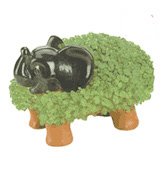
Americans' fascation with "Chia Pets" may have waned 15 years ago, but apparently the public's craving for inexpensive automobile replacement parts has combined with the tiny seedlings to spark a potential world-wide economic crisis with long-term consequences unlike anything seen since the 1820s. And many experts believe this is just the tip of the chia iceberg.
Last week investigators from the Department of Health and Environmental Control (DHEC), responding to an anonymous tip, discovered a massive illegal chia auto parts farm facility near Iva, South Carolina. Naturally camoflauged to blend with its environment, officials speculate the 450-acre chia "chop shop" may have been in operation since the late 1990s, and supplied counterfeit chia auto replacement parts to unwitting consumers throughout the eastern seaboard.
The demand for homegrown chia alternatives has sky-rocketed in recent years because manufacturers like GM, Jeep and Yugo have been unable to meet consumer demand for inexpensive factory-original parts like brake rotors, oxygen sensors and wheel covers. The price difference between a genuine part and a counterfeit is often staggering.
In an interview taped last Saturday Ed "Little Ernie" Noid, owner of "We Fix So You Can Git" in downtown Starr, told reporters his customers could expect to pay about $4000 for a factory-warrantied GM replacement engine.
Noid's seen counterfeit GM engines grown from chia substitute sell for as little as $29.95
What's exasperated the problem from a law enforcement perspective is that chia-grown parts have improved to the extent that even experts often find it difficult to tell the difference between a factory-installed transmission, and a mildew lookalike that simply grew in its place. Officials speculate that total revenues for the illicit chia auto parts industry could be as high as $3.7 billion annually.
Enterprising chia chop shops in fungus-friendly climates like South Carolina, Georgia and Louisiana began fabricating crude chia replacement hubcaps and grilles in the mid 1980s after kudzu was found to be an unsatisfactory substitute ... even for easily-manufactured items like carpet and seat upholstery.
Not only did kudzu ultimately prove to be high-maintenance, frequently requiring daily summer trimming. but kudzu was also very susceptible to leaf mold and bag worm infestations. Even kudzu seat cover enthusiasts admit the vine can cause itchy, oozing rashes.
And although the Salvia Columbariae seeds used to fashion chia pistons and engine blocks may seem enviromentally friendly, experts point out there's just no way to predict what may occur during the next 20 years.
Bi-County Tech Computer Science Professor Chaurlyne Orangello confides we may be on the verge of a chia revolution. "Unless the situation changes dramatically ... and soon, I have little doubt we'll see the first counterfeit Chinese chia Ipods on our street corners sometime this year. Then chia-chip computers ... and after that chia motorcycles and chia big screen tvs ... this may in hindsight turn out to be the century of the chia."


No comments:
Post a Comment